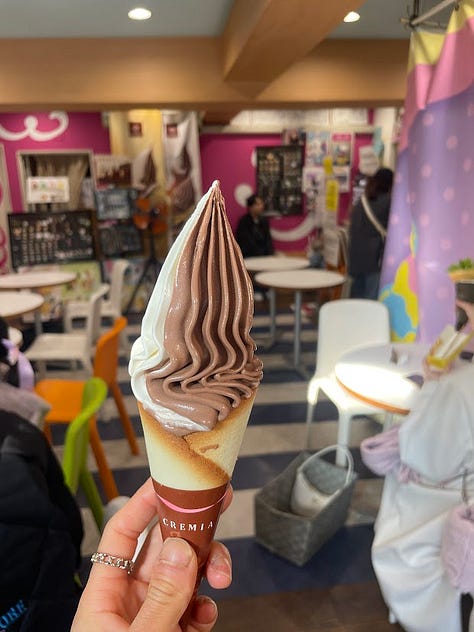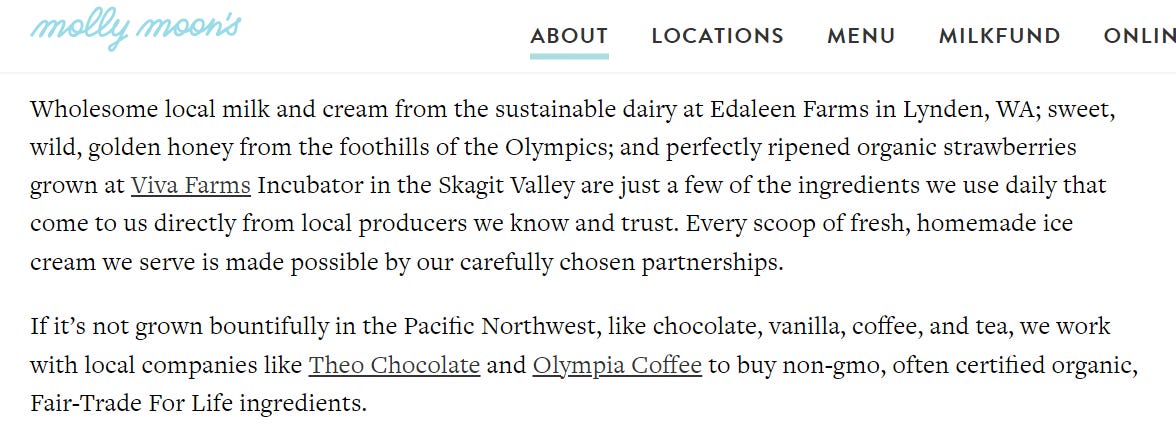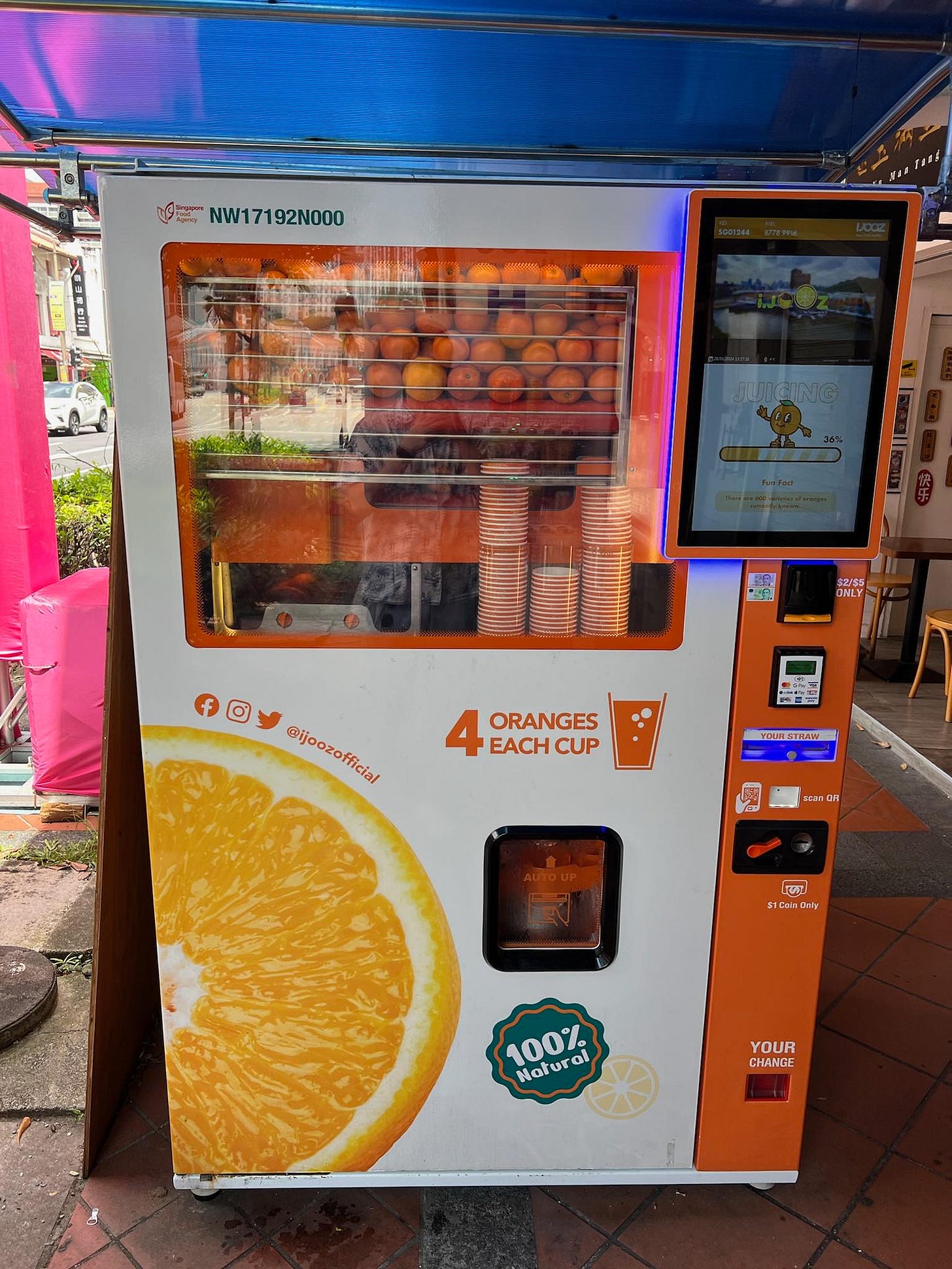With the amount of dairy I consume in the form of yogurt and ice cream, no one believes me when I say I’m lactose intolerant. From drinkable pouched Chinese yogurt to gelato at Frigidarium in Rome, I keep trying to replicate these life-changing indulgences in the United States. My latest fascination is Cremia, a premium Japanese soft serve brand that I won’t stop raving about. Mind you, I had ice cream more days than not in Asia and even in the U.S., but nothing compares to that jolt of pleasure starting at my tongue and lighting up my eyes.
Why is Cremia—and Japanese soft serve in general—so much better than American offerings? And what does dairy dessert reflect about a country’s culture, business philosophy, and consumer preferences?
Overview
Cremia is Japan’s premium softcream (soft serve ice cream) brand known for its luxurious milk flavor, silky smooth consistency, and its crispy butter cookie cone. It is found all over Japan and in some other East Asian cities in Taiwan and China, mainly by third-party distributors such as cafes and kiosks located inside subway stations and on shopping streets, which will have a large Cremia poster to indicate its availability.1 This distribution model is similar to ICEE, which has machines installed in movie theaters, convenience stores, fast food establishments, and grocery stores.
To better understand the brand, let’s compare it to the two kinds of ice cream/soft serve shops in the U.S. that occupy two extremes:
Your somewhat local premium shop with innovative flavor varieties. You go to these shops for the neighborhood feel and the friendly service. In my hometown, Molly Moon’s occupies this position.
Fast food soft serve, such as the infamous McDonald’s vanilla cone or Costco food court vanilla ice cream in a cup. At around $2-3, you know exactly what you’re going to get; you’ve gotten it before and you’ll get it again. Usually, it’s also eaten along with other “main course” food items.
Cremia is simultaneously neither of these yet also at their intersection. It has the premium quality associated with Molly Moon’s, the reliability and convenience of a McDonald’s cone, and a distribution model that combines the local and global feels.
The Product
Formula
Driven by a fiercely saturated soft serve market in Japan, Nissei (the country’s dominant softcream manufacturer), developed Cremia to target working women aged 20 to 30, who showed little interest in softcream products. After three years and 400 prototypes, Cremia was launched. The ice cream is made from Hokkaido milk with a fat content of 12.5% fat, up from the typical 8%. The sophisticated flavor highlights the natural sweetness and richness of the milk, with a subtle vanilla essence that complements rather than overwhelms. It is served in a specially designed cone made from langue de chat (a type of thin, sweet biscuit), which adds an element of gourmet indulgence to the experience.
Nutritionally, American soft serve tends to be of a lower fat percentage. The McDonald’s soft serve, for instance, has a fat content of 5%, which is not even legally considered ice cream. It’s vanilla is light, simple, and airy, appealing to a broad audience. The cone, while functional, sometimes tastes like cardboard.
The attention to detail in Cremia’s manufacturing process makes it comparable to the local premium ice cream brand, which often touts local, organic, sustainable ingredients.
But here’s one key difference: the cost for the latter is primarily variable (there’s a cost for every batch of ice cream produced), whereas Cremia’s research and development costs are upfront fixed costs. Fixed costs can be “recuperated” once Cremia makes enough revenue to break-even, so it is more economical in the long run.
Varieties
While flavor variety is often considered a positive attribute for local ice cream shops, it can also lead to decision paralysis. We all know that experience of testing sample after sample, all the flavors blending into one (what’s the difference between triple chocolate and double chocolate?). At the same time, plain vanilla can get boring.
Cremia occupies a sweet spot, with a limited selection of flavors and cone varieties. Most distributors offer plain, chocolate, and plain-chocolate mixes. However, other varieties include matcha, caramel, custard, and even berry and shine muscat in Taipei. Cone varieties include plain, chocolate, matcha, and berry. Only some distributors, particularly cafes, offer powdered toppings, such as matcha, durian (in Hong Kong), and cocoa. Sometimes it is served on top of French toast, or a part of coffee floats and parfaits.
Pricing
McDonald’s vanilla cone costs around $2 in the U.S., usually purchased as a dessert in conjunction with a larger fast-food meal. The plain Cremia is around $4, which is expensive compared to other Japanese soft serves, making it a premium product to be enjoyed as a standalone treat. However, for the American tourist, $4 is nothing compared to the $6.50 single scoop in a cup back at your local shop.
Distribution
As a universal icon, the McDonald’s cone is reliably accessible and essentially uniform all across the world (as long as the machines work). Similarly, the plain Cremia soft serve is consistent across all locations and is convenient to purchase. But the additional flavors, product offerings, and service quality vary by distributor. For instance, only the Shibuya location of the coffee chain Excelsior Cafe has Cremia, serving it in the plain flavor and regular cone with topping choices of matcha powder, cocoa powder, and biscoff cookies, and they even have Cremia coffee floats. By contrast, the Tsukiji Fish Market location just has a kiosk with the plain flavor and regular cone, and no available seating.



On the other hand, you go into a local shop expecting warm smiles and a community vibe. Sure enough, a key selling point of Molly Moon’s is its exceptional service. The company is also known for its contributions to the Seattle community and being an excellent employer:
As a value-maximizing tourist, I rarely want to repeat experiences. So, what led me to try Cremia four times, without any loss in indulgence? I’d argue that Cremia’s ability to drive repeated purchases hinges on its unique, high quality product and complementary distribution model.
The high quality of the ice cream enables the third party distribution model to work because customers are driven by the product itself, allowing room for variability in additional flavors, toppings, and service quality.
This scattered distribution model creates a simultaneous local and global feel, leading to a treasure hunt mentality. Cremia is not exclusive per se, as it is found across Japan (and other Asian cities), but its availability is unreliable in that it’s not offered at all locations under the same chain. So, there’s the knowledge that a Cremia is around the corner, but there are no rules for where it’s precisely located. Each Cremia distributor is seen as a hidden gem; you better buy it, or lose it. There’s a thrill in the chase of finding the next Cremia.
The company
Another often overlooked reason for Cremia’s success comes from the assets of its manufacturer, Nissei. The company made its mark by introducing soft serve ice cream to Japan in 1951 and has since held more than 60% of the country’s soft serve market, and is currently expanding to other regions of Asia. The company's foundational policy is to “Constantly innovate to become unique and No. 1” striving to provide delicious, enjoyable, and fantastic products that transcend generations and countries, contributing to a rich food culture.
Nissei is unique in that it's the only company in Japan capable of supplying a comprehensive range of products related to soft serve ice cream, including cone cups, soft serve mix, and freezers. Vertical integration allows a soft serve brand to control the supply chain's different stages, reducing costs and solidifying a competitive advantage:
Significant cost savings in raw materials, production, and distribution.
Quality assurance which is crucial to uphold the brand’s reputation.
Supply chain reliability, which is crucial given Cremia’s reliance on Hokkaido milk and specialized sugars.
Bargaining power with suppliers and distributors, from setting prices to determining product availability.
Barriers to entry for competitors due to proprietary recipes, specialized production, and exclusive access to premium ingredients.
Ice cream culture
Broadly speaking, the differences between American and Japanese ice cream reflect broader trends in how food is produced, presented, and enjoyed in different cultures, with Japanese ice cream focusing more on quality and subtlety, and American ice cream offering a diverse and customizable experience. Japan’s urban density and walkability has led to its strong street food and snack culture, as well as vending machine culture.2 They value quick, convenient, and often portable food items, which explains the prevalence of soft serve over traditional sit-down ice cream. Hence, quality is necessary to stand out in such a saturated market. Cremia specifically reflects Japanese business’s emphasis on developing a stellar production process, as also demonstrated by Toyota.
Meanwhile, in the U.S., it’s common to get soft serve is seen as lower-end, suitable for a drive-thru meal. Instead, value is placed on ice cream variety and personalization, reflecting the broader food trend toward mass customization (hence the rise of fast-casual restaurants) and America’s individualist culture. For these reasons, despite Cremia’s popularity, it might not be suitable for the American market, unless it’s a big cosmopolitan city.
Indeed, taking a look at the Asian soft serve brands in the U.S., they’re more targeted Asian-Americans or the cosmopolitan Gen Z rather than the entire American market. They’re never just plain milk flavor and a cone. Their competitive edge over other soft serve brands are their distinctly Asian flavors (such as matcha, black sesame, and ube) and toppings (mochi, taiyaki, pocky, etc). Even Indigo Cow, the first Hokkaido milk soft serve shop in America, pales in comparison to Cremia’s taste and leans into its Japanese identity.
Concluding thoughts
If Cremia were to expand outside Asia, it might be strategic to follow the footsteps of Japanese companies that don’t highlight themselves as Japanese. For instance, the premium coffee chain Arabica Coffee brands themselves as “the best coffee possible,” not the best Japanese coffee possible. Similar to how Cremia is made from Nissei’s special soft serve machines, Arabica is known for using its custom-made espresso machines.
Although Cremia began as a product created to appeal to a specific market of young professional women, its journey to an internationally recognized brand highlights the potential for high quality products to find a universal audience. Its allure, transcending mere taste to become a culinary experience, showcases the profound impact of cultural nuances and business acumen on the global ice cream landscape. Its seamless blend of premium quality, innovative distribution, and a keen understanding of consumer desires sets it apart, not just in Japan, but as a model of excellence in the dairy dessert domain.
In China, they were once offered at KFC, of all places.












